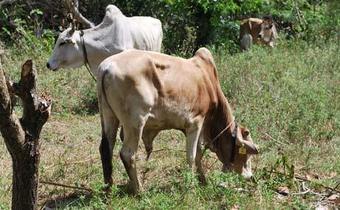 Sub-Saharan Africa livestock emit over 50 percent of global carbon, one of the gases blamed for change in climate, due to their overreliance on grasses and crop leftovers after harvest which are poor quality feeds according to a new report published by three international research institutions.
Sub-Saharan Africa livestock emit over 50 percent of global carbon, one of the gases blamed for change in climate, due to their overreliance on grasses and crop leftovers after harvest which are poor quality feeds according to a new report published by three international research institutions.
Researchers from the International Livestock Research Institute, the Common wealth Scientific, Industrial Research Organization and the International Institute for Applied Systems Analysis set out to analyze the carbon emissions by livestock from various parts of the world with varied feeding patterns.
They identified 8 different types of livestock systems in 28 geographic regions which included Africa, North America and Europe. They estimated number of cattle, small ruminants, pigs and poultry for each system for the year 2000. They also estimated greenhouse gas emissions produced by the livestock in that year for each region, system and species of animals
The results of their study showed that the quality of feed consumed by livestock contributes greatly to the amounts of greenhouse gases that they emit, with African cattle leading in the intensity of the gases released. “Cattle scrounging for food in the arid lands of Ethiopia, Somalia and Sudan can, in the worst cases, release the equivalent of 1,000 kilos of carbon for every kilo of protein they produce. Comparatively, in many parts of the United States and Europe, the emission intensity is around 10 kilos of carbon for a kilo of protein,” said a brief report highlighting the study.
African cattle thrive on low-quality rangeland grass or crop residue of low nutritional value, thus consuming huge amounts to produce meat or milk, and emitting large quantities of carbon into the environment, according to the report’s lead author, Mario Herrero, a chief research scientist with Australia-based CSIRO. “The study showed that the quality of an animal’s diet makes a major difference in both feed efficiency (ability to convert food to protein) and emission intensity,” Herrero added.
The report indicated that cattle are the biggest emitters of greenhouse gases worldwide, producing 77 percent of emissions whereas pork and poultry release only 10 percent, noting that cattle and other ruminants in Latin America, South Asia and Africa alone produce 75 percent of the world’s greenhouse gases.
In terms of feed, the study noted that livestock across the world consume about 1.3 billion tons of grain annually, with African animals consuming about 50 million tons of that, relying more on grasses and crop leftovers after harvest. Mariana Rufino, a Kenya-based senior climate scientist at the Center for International Forestry Research, said that improved feeds would greatly raise production while cutting emissions.
According to the scientists, policymakers need comprehensive data on livestock production systems and their environmental impacts globally to enable them design effective interventions. “This information will allow the global-change research community in enhancing our understanding of the sustainability of livestock systems and their role in food security, livelihoods and environmental sustainability,” the researchers wrote in the Proceedings of the National Academy of Sciences.